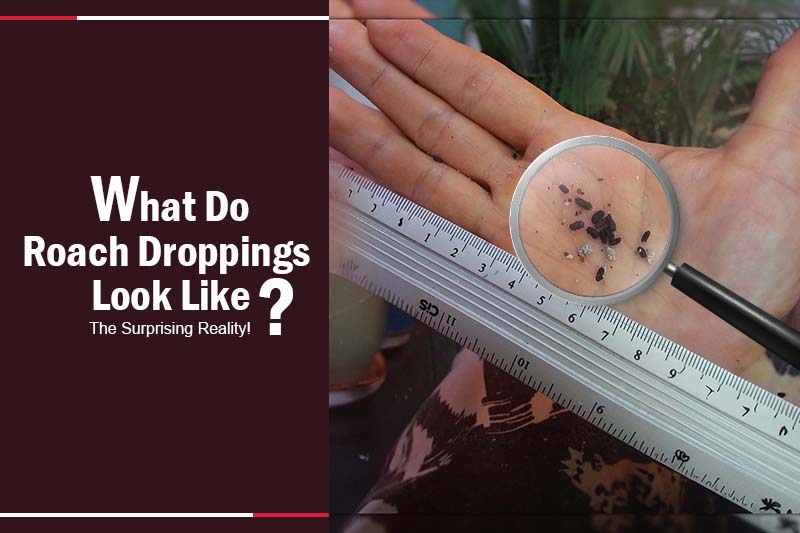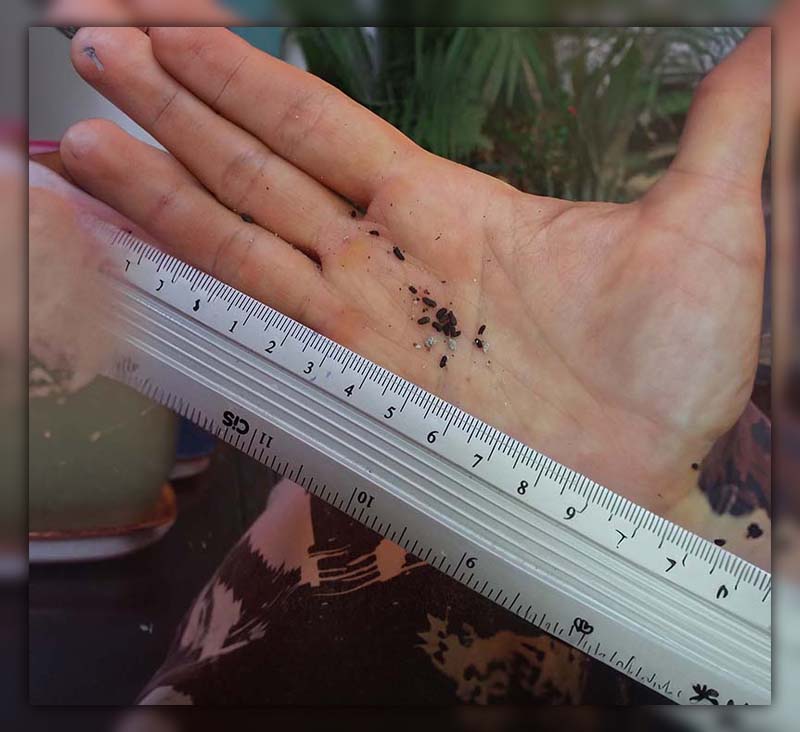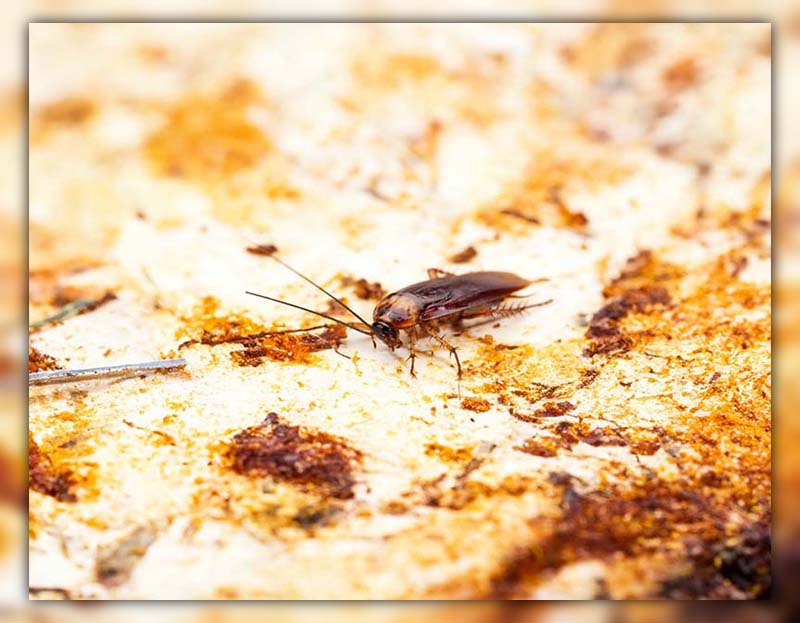What do roach droppings look like? Have you questioned whether those unusual sightings could be roach droppings, but aren’t quite sure?
In this blog, we’ll delve into the distinctive appearance of roach droppings and equip you with the knowledge you need to distinguish them from other household residues.

What do roach droppings look like?
Cockroach droppings come in various forms, depending on the size and age of the roaches.
These droppings are often easy to spot and serve as common indicators of roach presence.
Large Cockroach Droppings
When dealing with larger cockroaches, their droppings are quite distinguishable.
These droppings typically measure about an inch in length and have a cylindrical, solid shape.
Upon closer examination, you’ll notice ridges running from one end to the other, resembling the appearance of fennel seeds.
It’s important not to mistake these droppings for those of mice, as mouse droppings have a smooth surface.

Small Cockroach Droppings
In contrast, smaller roaches leave behind different types of droppings.
These droppings tend to be in the form of stains or small black specks, often resembling grains of black pepper or finely ground coffee.
The stains they leave can appear raised, smeared, and inky in nature.
>> Read more: Do Roaches Like Coffee? How to Keep Them Away From Coffee?
Baby Cockroach Droppings
Baby cockroaches, known as nymphs, also have their distinct droppings.
Large cockroach nymphs produce small, round droppings with ridges, while small nymphs excrete tiny black or brown specks.
These differences in droppings can help identify the presence of various roach species and their life stages.
Are cockroach droppings dangerous?
Indeed, cockroach droppings pose health risks and environmental concerns.
Studies have established a clear link between exposure to cockroach feces and an increased frequency and severity of asthma, leading the Environmental Protection Agency (EPA) to recognize them as asthma triggers.
Moreover, roach feces contribute to the characteristic musty odor associated with a cockroach infestation.
Furthermore, ignoring cockroach droppings can exacerbate infestations.
Roach feces contain an aggregation pheromone, effectively acting as a beckoning signal for other roaches to gather and congregate.
Pest management professionals leverage this knowledge by strategically placing bait near roach feces, attracting more roaches to the poison.
This approach capitalizes on the roaches’ natural response to the pheromone, ultimately aiding in pest control efforts.
>> Read more: Roaches in apartments: Causes and Solutions.

Where Should You Search for Cockroach Feces?
Cockroaches do not designate specific bathroom areas like humans; they defecate throughout their environment.
However, certain areas are more likely to have roach feces.
Cockroaches tend to defecate near their food sources and nesting or congregating areas.
Unfortunately, this often leads to food contamination and the potential spread of diseases, as their food sources are typically close to human food.
Roach feces can be found wherever roaches are present.
If you’ve spotted a roach scurrying behind a picture on the wall or under a bed, it’s probable that droppings are in those areas as well.
Common locations where cockroach droppings are found include:
- In the corners of rooms and along baseboards.
- On top of shelves, cabinets, doors, and other elevated objects that provide hidden passages.
- Inside drawers, pantries, closets, cabinets, and other areas used for food storage.
- Children’s playpens, toy chests, and items that children may touch.
- Underneath and behind appliances like refrigerators, stoves, washers, dryers, and sinks.
- Any cracks or openings in floors, walls, or structures in general.
- In storage areas, especially those with organic storage materials like cardboard boxes and papers.
Distinguish between roach poop vs mouse poop
Distinguishing between roach droppings vs mouse droppings is crucial for effective pest identification and control.
If you have both mice and cockroach feces in your vicinity, here are notable differences:
- Size and Texture: Cockroach droppings are smaller in size compared to mice droppings. Roach feces tend to have a rough, ridged texture, while mouse feces are mostly smooth.
- Shape: Roach droppings have a blunt shape at both ends. In contrast, mouse droppings are pointed at both ends, resembling small cylinders.
- Presence of Fur: Mouse droppings may have fur particles from the mouse’s body stuck to them, a feature typically absent in roach droppings.
>> Read more: How to clean roach poop: Pro Tips for a Spotless Home!

Do Cockroach feces have a smell?
Yes, cockroach feces do emit an acrid odor, characteristic of most animal excrement.
Interestingly, this odor serves a purpose within the roach community.
The scent acts as a trail for other roaches to follow, aiding in their ability to locate each other.
What if you see cockroach droppings but no cockroaches?
Discovering cockroach droppings without the presence of live roaches may indicate a past or relocated roach presence.
Roaches might have either perished or moved to a different area of your house.
The droppings left behind by previous roach activity will slowly decay unless cleaned or consumed by another roach. T
o ascertain if there is an ongoing cockroach infestation, promptly clean any droppings found and monitor for any reappearance.
If your living space remains free of droppings, it’s likely that the roach presence has been resolved.
However, if new droppings appear, this indicates the need to take action to exterminate the remaining roaches.
Conclusion
In conclusion, recognizing roach droppings and understanding what roach droppings look like is essential for effective pest management.
Comprehending their appearance, size, and characteristics can help you identify potential infestations and take appropriate action.
If you found this information helpful, we invite you to explore more insightful blogs on pest control and related topics at Pestweek.

Calina Mabel has over 15 years of experience in the field of journalism and communications. Currently, Calina Mabel is the Content Writer for categories such as Cockroach, Ants, Bed Bugs, Mosquito, Rodent, Termite, and Flies on Pestweek.com. She aims to build content for these categories with a focus on providing valuable and accessible information to readers, in order to create the world’s largest knowledge community about Pests.
All content written by Calina Mabel has been reviewed by Emily Carter.

